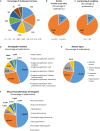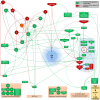Unraveling the Initial Plant Hormone Signaling, Metabolic Mechanisms and Plant Defense Triggering the Endomycorrhizal Symbiosis Behavior
- PMID: 30619390
- PMCID: PMC6304697
- DOI: 10.3389/fpls.2018.01800
Unraveling the Initial Plant Hormone Signaling, Metabolic Mechanisms and Plant Defense Triggering the Endomycorrhizal Symbiosis Behavior
Abstract
Arbuscular mycorrhizal (AM) fungi establish probably one of the oldest mutualistic relationships with the roots of most plants on earth. The wide distribution of these fungi in almost all soil ecotypes and the broad range of host plant species demonstrate their strong plasticity to cope with various environmental conditions. AM fungi elaborate fine-tuned molecular interactions with plants that determine their spread within root cortical tissues. Interactions with endomycorrhizal fungi can bring various benefits to plants, such as improved nutritional status, higher photosynthesis, protection against biotic and abiotic stresses based on regulation of many physiological processes which participate in promoting plant performances. In turn, host plants provide a specific habitat as physical support and a favorable metabolic frame, allowing uptake and assimilation of compounds required for the life cycle completion of these obligate biotrophic fungi. The search for formal and direct evidences of fungal energetic needs raised strong motivated projects since decades, but the impossibility to produce AM fungi under axenic conditions remains a deep enigma and still feeds numerous debates. Here, we review and discuss the initial favorable and non-favorable metabolic plant context that may fate the mycorrhizal behavior, with a focus on hormone interplays and their links with mitochondrial respiration, carbon partitioning and plant defense system, structured according to the action of phosphorus as a main limiting factor for mycorrhizal symbiosis. Then, we provide with models and discuss their significances to propose metabolic targets that could allow to develop innovations for the production and application of AM fungal inocula.
Keywords: carbon partitioning; mycorrhizal fungi; phosphorus; physiology; phytohormones; plant defense; plant priming; signaling.
Figures





References
-
- Adie B. A., Pérez-Pérez J., Pérez-Pérez M. M., Godoy M., Sánchez-Serrano J. J., Schmelz E. A., et al. (2007). ABA is an essential signal for plant resistance to pathogens affecting JA biosynthesis and the activation of defenses in Arabidopsis. Plant Cell 19 1665–1681. 10.1105/tpc.106.048041 - DOI - PMC - PubMed
Publication types
LinkOut - more resources
Full Text Sources
Miscellaneous

